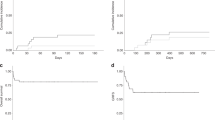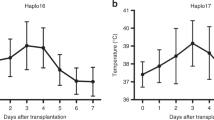Abstract
Fractionated TBI (FTBI) followed by allogeneic hematopoietic SCT results in donor engraftment and improves survival in children with high-risk hematologic malignancies. However, acute toxicities (skin, lung and mucosa) are common after FTBI. Late complications include cataracts, endocrine dysfunction, sterility and impaired neurodevelopment. Instead of FTBI, we used low-dose single fraction TBI (550 cGy) with CY as transplant conditioning for pediatric hematologic malignancies. GVHD prophylaxis included CYA and short-course MTX; methylprednisolone was added for unrelated donor transplants. A total of 55 children in first (40%) or second remission and beyond (60%) underwent transplantation from BM (65%) or peripheral blood; 62% from unrelated donors; 22% were mismatched. Median follow-up was 18.5 months (1–68). Overall survival and disease-free survival at 1 year were 60 and 47%, respectively. Acute toxicities included grade 3–4 mucositis (18%), invasive infections (11%), multiorgan failure/shock (11%), hemolytic anemia (7%), veno-occlusive disease (4%) and renal failure (4%). TRM was 11% at 100 days. Non-relapse mortality was 6% thereafter. Graft rejection occurred in 2%. Three patients (5%) died of GVHD. The regimen was well tolerated even in heavily pretreated children and supported donor cell engraftment; long-term follow up is in progress.
This is a preview of subscription content, access via your institution
Access options
Subscribe to this journal
Receive 12 print issues and online access
$259.00 per year
only $21.58 per issue
Buy this article
- Purchase on Springer Link
- Instant access to full article PDF
Prices may be subject to local taxes which are calculated during checkout

Similar content being viewed by others
References
Gale R, Butturini A, Bortin M . What does total body radiation do in bone marrow transplants for leukemia? Int J Radiat Oncol Biol Phys 1991; 20: 631–634.
Morgan M, Dodds A, Atkinson K, Szer J, Downs K, Bigg J . The toxicity of busulphan and cyclophosphamide as the preparative regimen for bone marrow transplantation. Br J Haematol 1991; 77: 529–534.
Matthes-Martin S, Lamche M, Ladenstein R, Emminger W, Felsberger C, Topf R et al. Organ toxicity and quality of life after allogeneic bone marrow transplantation in pediatric patients: a single centre retrospective analysis. Bone Marrow Transplant 1999; 23: 1049–1053.
Faraci M, Barra S, Cohen A, Lanino E, Grisolia F, Miano M et al. Very late nonfatal consequences of fractionated TBI in children undergoing bone marrow transplant. Int J Radiat Oncol Biol Phys 2005; 63: 1568–1575.
Sims S, Kazak A, Golomb V, Goldwein J, Bunin N . Cognitive, behavioral and social outcome in survivors of childhood stem cell transplantation. J Pediatr Hematol Oncol 2002; 24: 115–119.
Schwartz J, Yeager A . Reduced-intensity allogeneic hematopoietic cell transplantation: graft versus tumor effects with decreased toxicity. Pediatr Transplant 2003; 7: 168–178.
Roman E, Cooney E, Harrison L, Militano O, Wolownik K, Hawks R et al. Preliminary results of the safety of immunotherapy with gemtuzumab ozogamicin following reduced intensity allogeneic stem cell transplant in children with CD33+ acute myeloid leukemia. Clin Cancer Res 2005; 11: 7164s–7170s.
Davies S, Ramsay N, Klein J, Weisdorf D, Bolwell B, Cahn J et al. Comparison of preparative regimens in transplants for children with acute lymphoblastic leukemia. J Clin Oncol 2000; 18: 340–347.
Bunin N, Aplenc R, Kamani N, Shaw K, Cnaan A, Simms S . Randomized trial of busulfan vs total body irradiation containing conditioning regimens for children with acute lymphoblastic leukemia: a Pediatric Blood and Marrow Transplant Consortium study. Bone Marrow Transplant 2003; 32: 543–548.
Eapen M, Raetz E, Zhang M, Muehlenbein C, Devidas M, Abshire T et al. Outcomes after HLA-matched sibling transplantation or chemotherapy in children with B-precursor acute lymphoblastic leukemia in second remission: a collaborative study of the Children's Oncology Group and the Center for International Bone Marrow Transplant Research. Blood 2006; 107: 4961–4967.
Storb R, Raff R, Appelbaum F, Deeg H, Graham T, Schuening F . Fractionated versus single-dose total body irradiation at low and high dose rates to condition canine littermates for DLA-identical marrow grafts. Blood 1994; 83: 3384–3389.
Down J, Tarbell N, Thames H, Mauch P . Syngeneic and allogeneic bone marrow engraftment after total body irradiation: dependence on dose, rate, and fractionation. Blood 1991; 77: 661–669.
Khoury H, Adkins D, Brown R, Pence H, Vij R, Goodnough L et al. Low incidence of transplantation-related acute complications in patients with chronic myeloid leukemia undergoing allogeneic stem cell transplantation with low-dose (550 cGy) total body irradiation conditioning regimen. Biol Blood Marrow Transplant 2001; 7: 352–358.
Blum W, Brown R, Lin H, Zehnbauer B, Khoury H, Goodnough L et al. Low dose (550 cGy), single exposure total body irradiation and cyclophosphamide: consistent, durable engraftment of related-donor peripheral blood stem cells with low treatment-related mortality and fatal organ toxicity. Biol Blood Marrow Transplant 2002; 8: 608–618.
Hallemeier C, Girgis M, Blum W, Brown R, Khoury H, Goodnough L et al. Outcomes of adults with acute myelogenous leukemia in remission given 550 cGy of single-exposure total body irradiation, cyclophosphamide, and unrelated donor bone marrow transplants. Biol Blood Marrow Transplant 2004; 10: 310–319.
Girgis M, Hallemeier C, Blum W, Brown R, Lin H, Khoury H et al. Chimerism and clinical outcomes of 110 recipients of unrelated donor bone marrow transplants who underwent conditioning with low-dose, single-exposure total body irradiation and cyclophosphamide. Blood 2005; 105: 3035–3041.
Blood Marrow Transplant Clinical Trials Network, Technical Manual of Procedures, Version 2.0. National Institutes of Health; National Heart Lung Blood Institute; National Cancer Institute, Rockville, MD, USA, 2005.
Przepiorka D, Weisdorf D, Martin P, Klingemann H, Beatty P, Hows J, et al. Consensus conference on acute GVHD grading. Bone Marrow Transplant 1995; 15: 825–828.
Rankin K, Jones D, Redding S . Oral Health in Cancer Therapy: A Guide for Health Care Professionals, 2nd edn. Texas Cancer Council: Dallas, 2003.
Hartsell W, Czyzewski E, Ghalie R, Kaizer H . Pulmonary complications of bone marrow transplantation: a comparison of total body irradiation and cyclophosphamide to busulfan and cyclophosphamide. Int J Radiat Oncol Biol Phys 1995; 32: 69–73.
Ozsahin M, Belkacemi Y, Pene F, Laporte J, Rio B, Leblond V et al. Interstitial pneumonitis following autologous bone-marrow transplantation conditioned with cyclophosphamide and total-body irradiation. Int J Radiat Oncol Biol Phys 1996; 34: 71–77.
Pasquini MC, Wang Z . Current use and outcome of hematopoietic stem cell transplantation: part II—CIBMTR Summary Slides 2007 CIBMTR Newsletter (serial online) 2008; 14: 6–13.
Gibson B, Wheatley K, Hann I, Stevens R, Webb D, Hills R et al. Treatment strategy and long-term results in paediatric patients treated in consecutive UK AML trials. Leukemia 2005; 19: 2130–2138.
Lazarus H, Perez W, LKlein J, Kollman C, Bate-Boyle B, Bredenson C et al. Autotransplantation versus HLA-matched unrelated donor transplantation for acute myeloid leukemia: a retrospective analysis from the Center for International Bone Marrow Transplant Research. Br J Haematol 2006; 132: 755–769.
Ravindranath Y, Chang M, Steuber C, Becton D, Dahl G, Civin C et al. Pediatric Oncology Group (POG) studies of acute myeloid leukemia (AML): a review of four consecutive childhood AML trials conducted between 1981 and 2000. Leukemia 2005; 19: 2101–2116.
Meisel R, Laws H, Balzer S, Bernbeck B, Kramm C, Schonberger S et al. Comparable long-term survival after bone marrow versus peripheral blood progenitor cell transplantation from matched unrelated donors in children with hematologic malignancies. Biol Blood Marrow Transplant 2007; 13: 1338–1345.
Malempati S, Gaynon P, Sather H, La M, Stork L, Children's Oncology Group. Outcome after relapse among children with standard-risk acute lymphoblastic leukemia: Children's Oncology Group Study CCG-1952. J Clin Oncol 2007; 25: 5800–5807.
Gassas A, Sung L, Saunders E, Doyle J . Graft-versus-leukaemia effect in hematopoietic stem cell transplantation for pediatric acute lymphoblastic leukaemia: significantly lower relapse rate in unrelated transplantations. Bone Marrow Transplant 2007; 40: 951–955.
Michel G, Gluckman E, Esperou-Bordeau H, Reiffers J, OPico J, Bordigoni P et al. Allogeneic bone marrow transplantation for children with acute myeloblastic leukemia in first complete remission: impact of conditioning regimen without total-body irradiation—a report from the Societe Francaise de Greffe de Moelle. J Clin Oncol 1994; 12: 1217–1222.
Gassas A, Ishaqi M, Afzal S, Finkelstein-Shecter T, Dupuis A, Doyle J . A comparison of outcomes of children with acute myelogenous leukemia in either first or second complete remission (CR1 vs CR2) following allogeneic hematopoietic stem cell transplantation at a single transplant center. Bone Marrow Transplant 2008; 41: 941–945.
Shenoy S, Smith F . Hematopoietic stem cell transplantation for childhood malignancies of myeloid origin. Bone Marrow Transplant 2008; 41: 141–148.
Sedlacek P, Formankova R, Mejstrikova E, Keslova P, Hubacek P, Dobrovolna M et al. Allogeneic stem cell transplantation in children with leukemia using human leukocyte antigen-mismatched unrelated donors. Pediatr Transplant 2008; 12: 24–31.
Acknowledgements
This work was supported in part by the National Institutes of Health under the Ruth L Kirschstein National Research Service Award T32 HD 007499 from the NICHD (TED).
Author information
Authors and Affiliations
Corresponding author
Rights and permissions
About this article
Cite this article
Druley, T., Hayashi, R., Mansur, D. et al. Early outcomes after allogeneic hematopoietic SCT in pediatric patients with hematologic malignancies following single fraction TBI. Bone Marrow Transplant 43, 307–314 (2009). https://doi.org/10.1038/bmt.2008.327
Received:
Revised:
Accepted:
Published:
Issue Date:
DOI: https://doi.org/10.1038/bmt.2008.327
Keywords
This article is cited by
-
Perspectives toward oral mucositis prevention from parents and health care professionals in pediatric cancer
Supportive Care in Cancer (2012)
-
Psychometric properties of the Oral Mucositis Daily Questionnaire for child self-report and importance of mucositis in children treated with chemotherapy
Supportive Care in Cancer (2012)



